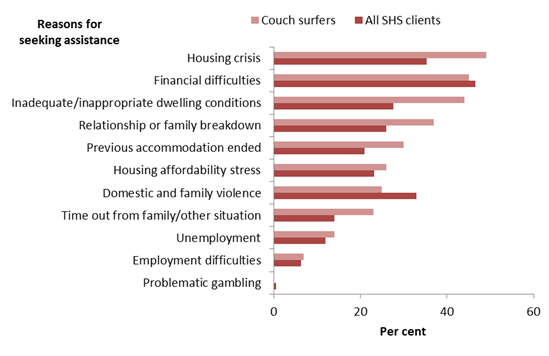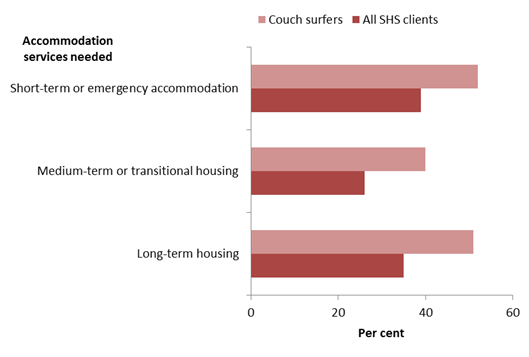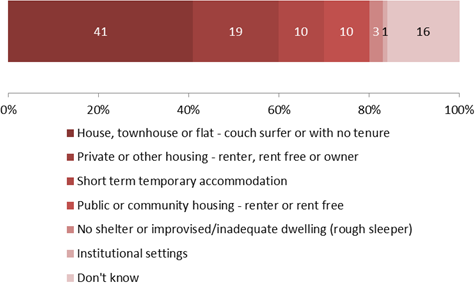Couch surfers
For the purposes of the Specialist Homelessness Services Collection (SHSC), a couch surfer is a client who typically moves from household to household intermittently, who is not regarded as being part of the household, and who does not have any form of leased tenure over any accommodation [1].
Couch surfers are usually included as a subset of those clients in short-term or emergency accommodation. For the purposes of this analysis, couch surfers are being examined separately as they are demographically different to the other clients in short-term or emergency accommodation.
Who is couch surfing?
Between 2011-12 and 2014-15, a total of 52,729 clients (12% of all Specialist Homelessness Services (SHS) clients aged 15 and over) were couch surfing upon first presentation to SHS. Per year, this ranged from 15,836 in 2011-12 to 20,839 in 2014-15, peaking at 21,028 in 2013-14.
@import url( /WorkArea/DownloadAsset.aspx?id=60129546273 );Typically couch surfers are…
female, aged less than 25 years, unemployed and located in Major cities.
Overview of cohort characteristics
| Characteristic | Couch sleepers | SHSC population |
|---|---|---|
| Female | 58% | 61% |
| Aged 15–24 | 47% | 29% |
| Indigenous | 21% | 16% |
| Employed | 10% | 13% |
| Lived in a Major city | 58% | 64% |
| Presented alone | 34% | 36% |
| Reported having experienced domestic and family violence | 28% | 35% |
| Reported a mental health issue | 31% | 28% |
| Diagnosed with a mental health issue | 44% | 22% |
| Had an issue with drugs or substance abuse | 13% | 12% |
Additionally:
- While the proportion of couch surfers has remained consistent across financial years, the numbers are increasing.
- Almost half (47%) were aged 15-24 years, 23% were aged 25-34 years and 30% were aged 35 years or over. This is younger than the general SHS population where 29% were aged 15-24 years, and 46% were 35 years or over.
- 1 in 5 (21%) were Indigenous, which is higher than both the general SHS population (16%), and the Australian population (3%).
- 1 in 10 (10%) were employed which is lower than the general SHS population (13%).
- More than half (58%) were located in Major cities, which is lower than the general SHS population (64%). A further 39% were located in Inner- or Outer regional areas.
- 1 in 3 (34%) presented to SHS agencies alone while more than 1 in 4 (28%) presented with one or more children. Male couch surfers were more likely to present alone; female couch surfers were more likely to present with children or other family members.
- Almost 3 in 10 (28%) reported experiencing domestic and family violence, which is lower than in the general SHS population (35%). Around three times as many female couch surfers reported ever experiencing domestic and family violence than male couch surfers.
- Almost 1 in 3 (31%) reported a current mental health issue, higher than the general SHS population (28%). Around 1 in 4 (26%) couch surfers had a diagnosed mental health issue.
- More than 1 in 10 (13%) reported ever having an issue with drugs or substance abuse, in line with the general SHS population (12%). Male couch surfers are almost twice as likely as female couch surfers to report a drug or substance abuse issue.
Reasons for seeking assistance
The most common reasons couch surfers gave for seeking assistance from SHS were (Figure CS.1):
- accommodation issues: including housing crisis (49%), inadequate or inappropriate dwellings conditions (44%), or prior accommodation ending (30%)
- interpersonal relationships: including relationship or family breakdown (37%), domestic and family violence (25%), and time out from family/other situation (23%)
- financial reasons: primarily financial difficulties (45%), housing affordability stress (26%), unemployment (14%), employment difficulties (7%) or problematic gambling (less than 1%).
Figure CS.1: Reasons for seeking assistance, couch surfers and all SHS clients, 2011-2015 (per cent)

Source: Supplementary data source table.
Compared with general SHS clients, couch surfers were less likely to request assistance from SHS for:
- 'other' issues such as lack of family support or transition from care arrangements (40%, compared with 35% of SHS clients), or
- health reasons (26%; similar to SHS clients at 25%).
What services do couch surfers need and what services are provided?
Couch surfers are most likely to need accommodation services
At the time of presentation to SHS, almost three-quarters (73%) of couch surfers needed assistance with accommodation, compared with just over half (55%) of all SHS clients (Supplementary Tables CS.12; SHS.1). This need was highest for short-term or emergency accommodation and lowest for medium-term or transitional accommodation (Figure CS.2).
Figure CS.2: Accommodation services needed, couch surfers and all SHS clients, 2011-2015 (per cent)
 S
S
Source: Supplementary data source table.
In general, couch surfers were less likely to receive assistance with accommodation when compared with all SHS clients (49% compared with 57%, respectively).
Couch surfers were less likely than SHS clients to receive all forms of accommodation:
- short-term or emergency accommodation (54% compared with 65%)
- medium-term/transitional housing (25% compared with 30%)
- long-term housing (6% compared with 8%).
Difficulties with interpersonal relationships, including family breakdown was listed by more than half of all couch surfers (55%) as a reason for seeking assistance. A lower proportion of couch surfers were identified as needing these services, with around one-in five needing assistance with family relationships (21%) or domestic and family violence (17%).
Couch surfers were equally likely as typical SHS clients aged 15 and over to request assistance with the remaining general services.
Couch surfers are less likely to need assistance with domestic and family violence or assistance in sustaining tenancy
At the time of presentation to SHS, around 1 in 4 (26%) couch surfers needed assistance for health reasons. This is the same rate experienced by SHS clients aged 15 and over. But, couch surfers were less likely than SHS clients to need assistance with:
- domestic and family violence (17% of couch surfers; 27% of SHS clients)
- sustaining tenancy or preventing tenancy failure or eviction (30% of couch surfers; 34% of SHS clients).
It is important to note that these findings relate to all couch surfers, and the needs for males and females are likely to differ. This may be particularly in relation to domestic and family violence, and other relationship issues.
While the needs identified for couch surfers are largely consistent with typical SHS clients, couch surfers are marginally less likely to need assistance with legal services such as:
- legal information (14% of couch surfers; 17% of SHS clients)
- court support (7% of couch surfers; 10% of SHS clients).
Housing pathways for couch surfers
1 in 10 (10%) couch surfers experienced repeat homelessness between 2011-12 and 2014-15. This means that the client transitioned between being homeless, housed and then homeless again at least once during this time.
Female couch surfers were slightly more likely then male couch surfers to experience repeat homelessness over time (11% and 9%, respectively). Between 2011-12 and 2014-15, the number of both males and females who presented to SHS agencies as couch surfers and who have experienced more than one episode of homelessness increased, from 2,748 in 2011-12 to 3,266 in 2014-15, peaking at 4,008 in 2013-14.
This indicates that sustainable housing outcomes may be problematic for this group, particularly for females.
What are the housing outcomes for couch surfers?
More than 2 in 5 (41% or 21,539) clients who first presented to homelessness services as couch surfers remained couch surfing at the end of support. Almost 1 in 3 (29%) clients presenting as a couch surfer ended their support 'housed' (19% ended their support in private rental housing and 10% in public or community housing).
Other housing outcomes for couch surfers who sought assistance from SHS agencies included: transitioning to short term or emergency accommodation (10%), rough sleeping (3%), and ending support in an institutional setting (1%). Despite support periods being closed, the housing outcome for almost 1 in 5 (16%) couch surfers was unknown at the end of their support (Figure CS.3).
Figure CS.3: Housing outcomes, couch surfers, 2011-2015 (per cent)

Source: Supplementary data source table.
Compared with the total couch surfer population, those that ended their support 'housed' were more likely to: be female, have experienced domestic and family violence, have reported experiencing a mental health issue, be located in a Major city, and presented to services accompanied by children. They are less likely to present to services alone, or to have experienced repeated episodes of homelessness (Table CS.2).
| Characteristic | 'Housed' couch surfers | Total couch surfer population |
|---|---|---|
| Female | 66% | 58% |
| Reported having experienced domestic or family violence | 34% | 28% |
| Reported having experienced a mental health issue | 37% | 31% |
| Presented with one or more children | 35% | 28% |
| Located in Major cities | 54% | 58% |
| Presented alone | 27% | 34% |
| Experienced repeated episodes of homelessness | 13% | 16% |
References
- Australian Institute of Health and Welfare (AIHW) 2013. Specialist Homelessness Services Collection manual. Cat. No. HOU 268. Canberra: AIHW.


